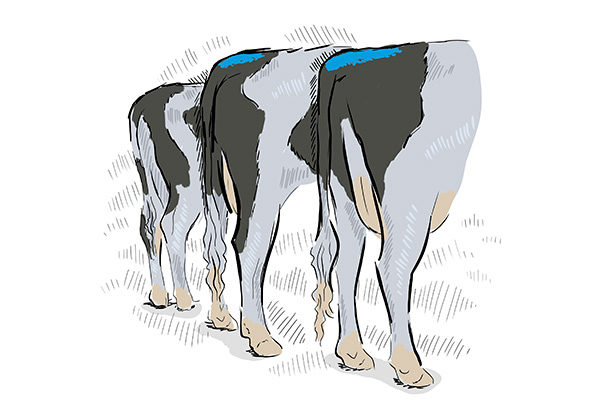Can you recall a time when natural service was the most common reproduction protocol, tail chalking was the most important task, and prostaglandin was the only hormone used to create pregnancies? The days before the Ovsynch protocol was introduced to the dairy industry seem like a distant memory.
How exactly did this protocol used so commonly in the dairy industry come to be?
As most innovations do, it started with a question. Actually, it started with a few.
Richard Pursley and Milo Wiltbank were studying how a cow recognizes a pregnancy at the University of Wisconsin – Madison in 1993. Wiltbank was a new faculty member, Pursley a graduate student returning to his education after owning and operating his own dairy. The pair was trying to understand the maternal recognition of pregnancy – why doesn’t a corpus luteum regress when an animal is pregnant? Pursley was implanting embryos and studying this question when he and Wiltbank started talking about some data they had seen, in which follicles would ovulate at different stages of the estrus cycle following a dose of GnRH. After many conversations and brainstorms, Wiltbank posed the question: What if you could use GnRH to time insemination?
Chasing this answer, the pair used 10 Holsteins from UW – Madison’s herd to begin experimenting. They began by administering a shot of GnRH (Day 0) and on Day 7, a shot of PGF2a. Day 9 another shot of GnRH was given, and insemination the following day. Each day, each animal was scanned via ultrasound, measuring follicles and corpora lutea.
“We didn’t really know what the ideal timing was with any of this,” Pursley recalls. “Basically, our thinking was: How long do we need to wait from the GnRH shot to the prostaglandin in order to regress the new CL? How long do we wait from the prostaglandin dose to the final GnRH dose so we can control the timing of the LH surge?”
Of the original 10 cows, seven became pregnant.
“Obviously we were really excited about this because there was nothing in the industry that could get seven of 10 cows pregnant,” Pursley says. “But we decided that we should try this with another 10 cows.”
Pursley laughed as he recalled only three of the next set of 10 cows getting pregnant, considering it a lesson in statistics. He and Wiltbank decided they needed more time to prove this experiment improved fertility. The pair did publish the original study on the first 20 cows, however, and it became one of the most cited papers in the reproduction sector of science – claiming spot No. 7 on Oxford Academic’s “100 papers to read before you die.”
The pair went to work studying this idea and began conducting “real” experiments – comparing synchronization of ovulation to regular estrus, determining the ideal timing of A.I. in relation to the final GnRH shot of the program, etc.
As Pursley and Wiltbank devoted more time to the “synchronization of ovulation,” the two agreed the name was a bit long.
“I remember sitting in front of what was possibly the first version of a Mac in my office and telling Milo one day, ‘We need to find a simpler name for this,’” Pursley recalls. “I said, ‘What about Ovsynch?’ Milo just laughed and we both knew that was it.”
Before the introduction of Ovsynch, many producers would breed cows as early as possible – fearing they might not give cows enough chances to get pregnant before they are too far out in lactation – which could result in culling. With Ovsynch, producers now had the opportunity to select an optimal time for breeding and plan accordingly – resulting in increased pregnancy rates.
“The beauty was you can really enhance preg rates,” Pursley says. “People really liked that because they’re getting cows – a lot more cows – pregnant sooner. That was incredibly obvious.”
The next question asked was: How can Ovsynch improve conception rates?
Initially, cows enrolled in an Ovsynch protocol did not have higher conception rates than cows bred by detected estrus. As the industry started to use this program, other researchers began experimenting to improve conception rates.
“I think the first time someone did this, they gave two injections of prostaglandin 14 days apart,” Pursley says. “The period from the second prostaglandin shot to the first Ovsynch shot was experimented with: 11 days, 12 days, 14 days. When using that 11- or 12-day period, we started seeing better fertility.”
Reason being: The Ovsynch protocol was being started at a better time of the estrus cycle. As researchers began to understand follicular wave growth, they were able to adjust the Ovsynch protocol – figuring out how to time shots with follicle growth was a breakthrough.
“Compared to the original program, almost all cows are synchronizing in a way that follicle development and CL development both are almost totally controlled,” Pursley says. “Milo’s (Wiltbank) data indicated that we were having problems regressing the CL; one of his students we were working with added a second prostaglandin shot 24 hours later to both the Ovsynch and Double Ovsynch programs and that improved fertility by about five percentage points.”
Before the Ovsynch protocol was officially published, articles were written on the practice and word started to spread of the new method.
“We got a lot of phone calls,” Pursley says. “Good and bad ones – mostly good. People would call us after trying Ovsynch for a few months and say, ‘This is really working!’ We got a lot of good feedback early on. The bad phone calls were mostly in regard to the price of GnRH and prostaglandin – we had quoted a price in that article that was a little under what the actual price of the drugs were. Both drugs were pricey back then compared to today.
“The one (call) that I probably remember the most was from Dr. Bill Thatcher from Florida,” Pursley recalls. “He called Milo (Wiltbank) and told him that he’d been using Ovsynch. He said something about how seldom you can repeat someone else’s work and get the same result; that really gave us a lot of satisfaction that a person of his stature would call us and let us know that this protocol had turned out exactly how we said it would when we published it.”
Today Ovsynch is a standard practice used in the dairy industry, the beef industry has dabbled in this practice, and it has been used on water buffalo and yaks. There are seven different variations of the original Ovsynch protocol: Presynch, Double Ovsynch, G-6-G, Ovsynch 56, Ovsynch 48, Cosynch 72, 5-day Cosynch.
“It’s fun to look back from a historical standpoint and put it into perspective now,” Pursley says. “What it means now and what it could mean in the future.”







